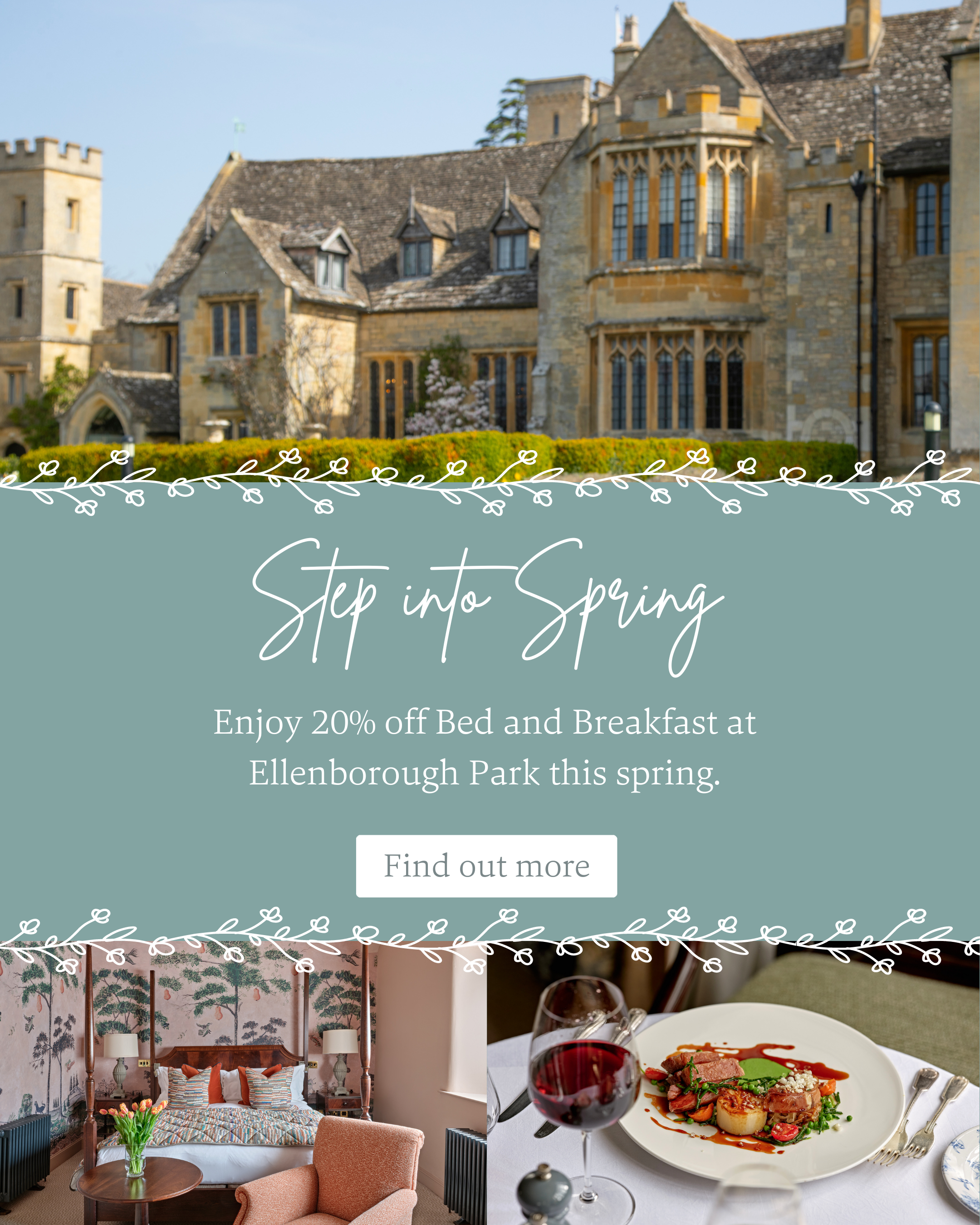The story of Ellenborough Park - so far, at least
History
Our manor house and estate is a bit of an institution in these parts. Although we've been welcoming guests through the door since 1973, the building itself has been standing for over 500 years.
2000 BC
Our wonderful spot at the foot of Cleeve Hill was occupied well before our house was built. Evidence suggests that people have been calling this corner of the Cotswolds home for thousands of years. The skeleton of a Beaker man nearby dates early settlements all the way back to 2000BC.
899 AD
In the earliest records available, the Bishop of Hereford had built a large manor house on the outskirts of the current site of Cheltenham Racecourse, complete with a range of buildings and access to a three-mile hunting forest stocked with deer. The house would eventually pass into the hands of Queen Elizabeth I, before being dismantled to renovate St Mary's Church in Prestbury. There is now very little to see of the original building above ground
1485
When tenant farmer, Thomas Goodman, moved to the site of our current estate, he set about building a house block by block. Horse-and-carting his stone and lumber from his home in nearby Southam, began building the foundations of what was to become Ellenborough Park - starting with our unmistakably ancient Great Hall.
His original coat of arms can still be seen on the front door (as well as bullet holes from the Civil War), as can the stained glass windows commemorating Henry VI and Elizabeth of York.
1520
Thomas Goodman sold the unfinished house to Sir John Huddleston, who dedicated himself to the restoration of Southam House, which remains at the heart of Ellenborough Park. As a keen supporter of the Yorkist cause during the War of the Roses, he was rewarded with the position of Constable of Sudeley Castle and High Sheriff of Gloucester. When Richard III was defeated at the Battle of Bosworth, Sir John and his son, Henry, fled the battlefield and went into hiding. Fortunately, Henry VII pardoned them and the family continued to prosper.
You'll still find the Tudor Rose in our Restaurant's windows, created as a sign of respect towards the new king.
1554
Sir John's granddaughter, Eleanor, married Kinnard De la Bere, whose family arrived in Britain with the Norman invasion. The couple spent many happy years living in the house, and the crest which represents their marriage still sits above the fireplace in the Restaurant. The house then passed to their son, Richard, who bought nearby Southam Manor with its lands and funded considerable developments within Southam House, including the oak panelling throughout many of the rooms.
1788
Southam House remained in the hands of the De la Bere family for well over 200 years, even hosting King George III during his extended stay in Cheltenham to access the spa waters.
1833
In 1833, the estate was eventually sold to Edward Law - the future Viscount Southam, 2nd Lord Ellenborough, 1st Earl of Ellenborough and Governor General of India. A Tory politician who had made a name for himself in the Duke of Wellington's government, Edward was a brilliant orator and administrator, but was also known for being vain and disagreeable - and for his tumultuous love life with Lady Jane Digby.
1862
The Earl maintained the original features of the house with a passion. Towers were added, giving the appearance of a castle. The stable block, chapel and India Memorial Gazebo were added with a secret passage way. Relics brought back from Indian Palaces still adorn the building.
1871
The Earl died in 1871, aged 81. Southam De la Bere, as it had now become known, became home to Mrs Ratcliff and her daughters Lilian and Phyllis. Withstanding the brutal force of two World Wars, the women spent many happy years here, working locally, nursing soldiers back to health and supporting the local community holding parties and pageants.
1947
In 1947, Southam De la Bere became the Oriel High School for Girls. Home to 70 boarders and 30 day pupils, the school was seen as a happy, if not a little eccentric, place. In the years since the school closed in 1972, we've hosted reunions and heard plenty of gossip over a cream tea - including tales of smuggling boys into the building.
1973
It wasn't until 1973 that the house first became a hotel. The De La Bere Hotel operated under various different management teams right up until 2008, before closing due to financial difficulties.
2008
By 2008, the house was in desperate need of a total refurbishment. The whole hotel was closed for over two years to allow time for a full renovation to take place. Several rooms were stripped right back to the bare bones, original features were restored, and the staircase was removed and taken away to be worked on. The estate was also expanded from the remaining ten acres to encompass 90 acres, stretching from the Racecourse up to Cleeve Hill.
2010
Ellenborough Park opened its doors for the first time in 2010. With 61 rooms, 90 acres of grounds, and a fully restored suite of facilities, it wasn't long before the house became one of the Cotswolds' best-loved spots.


